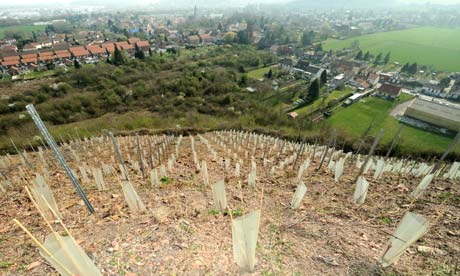From mines to fine wines: French growers plant vines on old slag heap
French winemakers believe they can turn around the fortunes of Haillicourt, a depressed former pit village in the Pas-de-Calais

To the French, it's grim up north, around the Channel towns of Calais and Boulogne: a desolate and dreary region of once industrialised flatlands pockmarked by the slag heaps of a defunct coal-mining industry.
Emile Zola saw hope of a better future here in his 19th-century masterpiece Germinal – but even he could not have predicted it would come in the shape of a grape, a vine and a bottle.
Yet French winegrowers now hope to produce a decent vin blanc from chardonnay grapes grown on the steep slopes of a slag heap overlooking the village of Haillicourt, less than an hour's drive to the south-east of Calais.
The aim of the experiment, they say, is to produce a drink that is not only palatable but of high quality, and in so doing to revive the fortunes of this economically depressed region.
The man behind the trial is Olivier Pucek, an engineer and civil servant, who was born in the Pas-de-Calais "at the foot of a slag heap". Pucek, who moved away and runs his own vineyard "as a hobby" in the wine-producing Charentes region in western France, got together five winemaking friends to plant 3,000 vines halfway up the southern slope of the mining waste tip. There, they say, the plants will benefit from the most sun and avoid the spring frosts.
The group has put up two thirds of the annual €24,000 (£21,000) cost of the project. The remaining third is being financed by the town hall at Haillicourt, where more than 23% of the 5,000-strong population are unemployed.
"The locals are delighted. They are very attached to their slag heaps, which have become part of the countryside and provoke a nostalgia for the mining heritage," Pucek said.
Life for locals had been "economically hard" since the last mine in Haillicourt closed, in 1985, he said. "This could lead to the regeneration of the whole region. It's an experiment, and the objective is to produce a wine that is not just drinkable but is of a high quality. If we can do it here, we can show it can be done elsewhere - even, perhaps, in Wales."
He admitted the wine, the first bottles of which will be produced in 2012, would probably have a "strong character. The only thing we are slightly worried about is how much it will be affected by the smell of coal," he said.
No comments:
Post a Comment